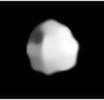18 Melpomene
 | |
| Discovery | |
|---|---|
| Discovered by | John Russell Hind |
| Discovery date | 24 June 1852 |
| Designations | |
| (18) Melpomene | |
| Pronunciation | /mɛlˈpɒmɪniː/[1] |
Named after | Melpomenē |
| Main belt | |
| Adjectives | Melpomenean /mɛlpɒmɪˈniːən/[2] |
| Symbol | |
| Orbital characteristics[3] | |
| Epoch 17.0 October 2024 (JD 2460600.5) | |
| Aphelion | 2.796 AU (418.3 million km) |
| Perihelion | 1.794 AU (268.4 million km) |
| 2.295 AU (343.3 million km) | |
| Eccentricity | 0.21827 |
| 1,269.91 d (3.48 yr) | |
| 113.8711° | |
| Inclination | 10.132° |
| 150.34° | |
| 2023-Sep-11 | |
| 228.05° | |
| Earth MOID | 0.81 AU (121 million km) |
| Jupiter MOID | 2.70 AU (404 million km) |
| TJupiter | 3.543 |
| Physical characteristics | |
| Dimensions | 170 × 155 × 129 km[4] (150 × 125 km)[5] (150 × 170 km)[6] |
| 141±2 km[7] 139.594±2.452 km[3] | |
| Flattening | 0.19[a] |
| Mass | (4.5±0.9)×1018 kg[7] 3.0×1018 kg[4] |
Mean density | 3.06±0.62 g/cm3[7] 1.69±0.66 g/cm3[4] |
| 11.57 h (0.48 d)[3] 11.570306±0.000005 h[7] 11.573 h (0.48 d)[8] | |
| 64°[7] | |
Pole ecliptic latitude | 19°±2°[7] |
Pole ecliptic longitude | 12°±2°[7] |
| 0.221 (calculated)[7] 0.223[9] 0.181 ± 0.033[3] | |
| S[3][7] | |
| 7.5[10] to 12.0 | |
| 6.35[3] 6.51[7] | |
| 0.23" to 0.059" | |
18 Melpomene is a large, bright main-belt asteroid that was discovered by J. R. Hind on 24 June 1852,[11] and named after Melpomenē, the Muse of tragedy in Greek mythology. Its historical symbol was a dagger over a star; it is in the pipeline for Unicode 17.0 as U+1CECB (![]() ).[12][13]
).[12][13]
Melpomene is classified as an S-type asteroid and is composed of silicates and metals. This asteroid is orbiting the Sun at a distance of 2.296 AU with a period of 3.48 years and an eccentricity (ovalness) of 0.22. The orbital plane is tilted at an angle of 10.1° to the plane of the ecliptic.[3]
Melpomene occulted the star SAO 114159 on 11 December 1978. A possible Melpomenean satellite with a diameter at least 37 km was detected. The satellite candidate received a provisional designation S/1978 (18) 1.[14] In 1988 a search for satellites or dust orbiting this asteroid was performed using the UH88 telescope at the Mauna Kea Observatories, but the effort came up empty.[15] Melpomene was observed with the Hubble Space Telescope in 1993. It was able to resolve the asteroid's slightly elongated shape, but no satellites were detected.[5]
Melpomene has been studied by radar.[16] Photometric observations during 2012 provided a rotation period of 11.571±0.001 h with a brightness variation of 0.34±0.02 in magnitude, which is consistent with previous studies.[17] It has a mean diameter of 141±2 km.[7][3]
Melpomene can reach an apparent magnitude of +7.9 at a favorable opposition near perihelion, such as occurred in September 2002 when it was 0.814 AU (121.8 million km; 317 LD) from Earth.[18]
Notes
References
- ^ Noah Webster (1884) A Practical Dictionary of the English Language
- ^ Tim Shephard (2014) Echoing Helicon
- ^ a b c d e f g h JPL SBDB: 18 Melpomene, NASA Jet Propulsion Laboratory, retrieved 21 December 2024
- ^ a b c Jim Baer (2008). "Recent Asteroid Mass Determinations". Personal Website. Archived from the original on 2 July 2013. Retrieved 27 November 2008.
- ^ a b Storrs, Alex; Weiss; Zellner; Burlsen; et al. (1999). "Imaging Observations of Asteroids with Hubble Space Telescope" (PDF). Icarus. 137 (2): 260–268. Bibcode:1999Icar..137..260S. doi:10.1006/icar.1999.6047. Archived from the original (PDF) on 30 October 2008. Retrieved 3 November 2008.
- ^ Storrs, Alex; Dunne; Conan; Mugnier; et al. (2005). "A closer look at main belt asteroids 1: WF/PC images" (PDF). Icarus. 173 (2): 409–416. Bibcode:2005Icar..173..409S. doi:10.1016/j.icarus.2004.08.007. Archived from the original (PDF) on 10 March 2012. Retrieved 26 November 2008.
- ^ a b c d e f g h i j k l Vernazza, P.; et al. (October 2021). "VLT/SPHERE imaging survey of the largest main-belt asteroids: Final results and synthesis". Astronomy & Astrophysics. 54. Bibcode:2021A&A...654A..56V. doi:10.1051/0004-6361/202141781. hdl:10261/263281. A56.
- ^ "Lightcurves and Map Data on Numbered Asteroids N° 1 TO 52225". AstroSurf. Archived from the original on 27 November 2005. Retrieved 3 November 2008.
- ^ "Asteroid Data Archive". Planetary Science Institute. Archived from the original on 23 June 2006. Retrieved 3 November 2008.
- ^ Menzel, Donald H.; Pasachoff, Jay M. (1983). A Field Guide to the Stars and Planets (2nd ed.). Boston, MA: Houghton Mifflin. p. 391. ISBN 0-395-34835-8.
- ^ "Numbered Minor Planets 1–5000", Discovery Circumstances, IAU Minor Planet center, retrieved 7 April 2013.
- ^ Bala, Gavin Jared; Miller, Kirk (18 September 2023). "Unicode request for historical asteroid symbols" (PDF). unicode.org. Unicode. Retrieved 26 September 2023.
- ^ Unicode. "Proposed New Characters: The Pipeline". unicode.org. The Unicode Consortium. Retrieved 6 November 2023.
- ^ IAUC 3315: 1978 (18) 1; WZ Sge, Central Bureau for Astronomical Telegrams, retrieved 5 July 2011.
- ^ Gradie, J.; Flynn, L. (March 1988), "A Search for Satellites and Dust Belts Around Asteroids: Negative Results", Abstracts of the Lunar and Planetary Science Conference, vol. 19, pp. 405–406, Bibcode:1988LPI....19..405G.
- ^ Radar-Detected Asteroids and Comets, NASA/JPL Asteroid Radar Research, retrieved 30 October 2011.
- ^ Pilcher, Frederick (January 2013). "Lightcurves and Derived Rotation Periods for 18 Melpomene 38 Leda, and 465 Alekto". Bulletin of the Minor Planets Section of the Association of Lunar and Planetary Observers. 40 (1): 33. Bibcode:2013MPBu...40...33P.
- ^ "Horizons Batch for September 2002". JPL Horizons. Retrieved 17 November 2022.
External links
- 18 Melpomene at AstDyS-2, Asteroids—Dynamic Site
- 18 Melpomene at the JPL Small-Body Database

